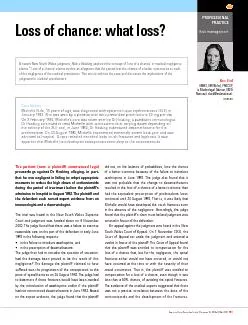

proceedings against Dr Hosking alleging in part that he was negligent in failing to adopt appropriate measures to reduce the high doses of corticosteroids during the period of treatment before th ID: 832237
Download Pdf The PPT/PDF document "The patient (now a plaintiff) commenced ..." is the property of its rightful owner. Permission is granted to download and print the materials on this web site for personal, non-commercial use only, and to display it on your personal computer provided you do not modify the materials and that you retain all copyright notices contained in the materials. By downloading content from our website, you accept the terms of this agreement.
The patient (now a plaintiff) commenced
The patient (now a plaintiff) commenced legal proceedings against Dr Hosking alleging, in part, that he was negligent in failing to adopt appropriate measures to reduce the high doses of corticosteroids during the period of treatment before the plaintiff’s admission to hospital in August 1992. The plaintiff and the defendant each served expert evidence from an immunologist and a rheumatologist. The trial was heard in the New South Wales Supreme Court and judgment was handed down on 6 November 2002. The judge found that there was a failure to exercise reasonable care on the part of the defendant in early June 1992 in the following respects:in the failure to introduce azathioprine, andin the prescription of dexamethasone.The judge then had to consider the question of causation: had the damage been proved to be the result of this negligence? The damage the plaintiff claimed to have suffered was the progression of the osteoporosis to the point of spinal fractures on 24 August 1992. The judge had to determine if those fractures would have been avoided by the introduction of azathioprine and/or if the plaintiff had not commenced dexamethasone in June 1992. Based on the expert evidence, the judge found that the plaintiff did not, on the balance of probabilities, lose the chance of a better outcome because of the failure to introduce azathioprine in June 1992. The judge also found that it was not probable that the change to dexamethasone resulted in the loss of a chance of a better outcome than had the equivalent prescription of prednisolone been continued until 24 August 1992. That is, it was likely that Michelle would have developed the crush fractures even in the absence of the negligence. Accordingly, the judge found that the plaintiff’s claim must fail and judgment was entered in favour of the defendant.An appeal against the judgment was heard in the New South Wales Court of Appeal. On 1 November 2004, the Court of Appeal set aside the judgment and entered a ve
rdict in favour of the plaintiff. The Co
rdict in favour of the plaintiff. The Court of Appeal found that the plaintiff was entitled to compensation for the loss of a chance that, but for the negligence, the spinal fractures either would not have occurred, or would not have occurred at the time or with the severity of their actual occurrence. That is, the plaintiff was entitled to compensation for a loss of a chance, even though it was less than a 50% chance, of avoiding the spinal fractures. The evidence of the medical experts suggested that there was not a precise correlation between the dose of the corticosteroids and the development of the fractures. Case historyMichelle Rufo, 14 years of age, was diagnosed with systemic lupus erythematosus (SLE) in January 1992. She was seen by a paediatrician who prescribed prednisolone 50 mg per day. On 3 February 1992, Michelle’s care was taken over by Dr Hosking, a paediatric immunologist. Dr Hosking continued to treat Michelle with corticosteroids at varying doses depending on the activity of the SLE and, in June 1992, Dr Hosking substituted dexamethasone for the prednisolone. On 24 August 1992, Michelle experienced extremely severe back pain and was admitted to hospital. X-rays revealed vertebral body crush fractures and kyphosis. It was apparent that Michelle had developed osteoporosis secondary to the corticosteroids.Sara BirdMBBS, MFM(clin), FRACGP, is Medicolegal Adviser, MDA National. sbird@mdanational.com.auA recent New South Wales judgment, Rufo v Hosking, explored the concept of ‘loss of a chance’ in medical negligence claims.1 ‘Loss of a chance’ claims involve an allegation that the patient lost the chance of a better outcome as a result of the negligence of the medical practitioner. This article outlines the case and discusses the implications of the judgment for medical practitioners.Loss of chance: what loss? PROFESSIONAL PRACTICE Risk managementReprinted from Australian Family Physician Vol. 35, No. 5, May 2006 351